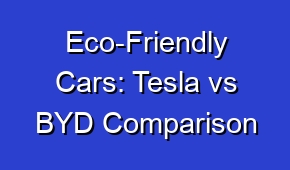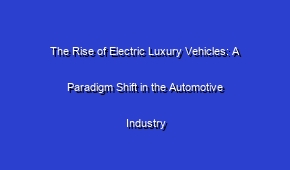Eco-Friendly Cars: Tesla vs BYD Comparison

Eco-friendly cars have become increasingly popular in recent years, with Tesla and BYD emerging as two prominent contenders in the market. In this article, we compare these two leading brands, exploring their key features and advantages. Discover which company offers the best eco-friendly car options for environmentally conscious consumers.
Eco-friendly cars have become increasingly popular in recent years, with Tesla and BYD emerging as two prominent contenders in the market. When comparing these two electric vehicle manufacturers, several factors come into play. Both Tesla and BYD offer a range of models that prioritize sustainability and energy efficiency. The Tesla lineup includes the highly acclaimed Model S, Model 3, and Model X, while BYD boasts the Tang EV and Qin Pro as top choices for environmentally conscious drivers. In terms of performance, Tesla excels with its cutting-edge technology and long-range capabilities, while BYD focuses on affordability without compromising on eco-friendliness. Additionally, both companies are committed to innovation and have made significant strides in advancing battery technology. Whether you choose Tesla or BYD, you can be confident that you are contributing to a greener future.
| Eco-friendly cars: Tesla to BYD compared |
| Tesla and BYD are two leading companies in the eco-friendly car market. |
| Tesla’s electric cars are known for their cutting-edge technology and performance. |
| BYD focuses on producing affordable electric vehicles for a wider market. |
| Tesla’s vehicles offer longer driving ranges compared to BYD’s models. |
- Tesla’s charging infrastructure is more extensive compared to BYD’s network.
- BYD’s electric cars are popular in China due to government support.
- Tesla’s Model 3 is one of the best-selling electric cars worldwide.
- BYD focuses on sustainable transportation solutions beyond just cars.
- Tesla’s Autopilot feature offers advanced autonomous driving capabilities.
What are the advantages of eco-friendly cars?
Eco-friendly cars offer several advantages compared to traditional gasoline-powered vehicles. Firstly, they significantly reduce greenhouse gas emissions, helping to combat climate change. They also have lower fuel consumption, which leads to cost savings for the owner. Additionally, eco-friendly cars often have advanced technologies and features that enhance safety and provide a smoother driving experience. Furthermore, these vehicles promote energy independence by reducing reliance on fossil fuels.
| Reduced Environmental Impact | Cost Savings | Improved Air Quality |
| Eco-friendly cars produce lower emissions, reducing air pollution and greenhouse gas emissions. | These cars require less fuel, resulting in cost savings on fuel expenses. | By emitting fewer pollutants, eco-friendly cars help improve air quality and reduce respiratory health issues. |
| They contribute to the conservation of natural resources and help combat climate change. | They often have lower maintenance and operational costs, saving money in the long run. | Reduced emissions of harmful gases and particles lead to cleaner and healthier air for everyone. |
| They promote sustainability and a greener future. | Government incentives and tax credits are often available for eco-friendly car owners. | Less noise pollution as electric and hybrid cars operate more quietly than traditional vehicles. |
How do Tesla and BYD compare in terms of eco-friendliness?
Both Tesla and BYD are known for their commitment to producing eco-friendly cars. Tesla is renowned for its electric vehicles (EVs) that have long driving ranges and impressive performance. They have a strong charging infrastructure and are constantly pushing the boundaries of EV technology. On the other hand, BYD is a Chinese automaker that specializes in electric and hybrid vehicles. They have made significant advancements in battery technology and offer a wide range of affordable electric cars. While Tesla focuses more on luxury and high-end models, BYD caters to a broader market with its diverse lineup.
- Tesla and BYD both prioritize eco-friendliness in their products and operations.
- Tesla is known for its electric vehicles, which produce zero emissions and help reduce air pollution. The company’s vehicles also use renewable energy sources, such as solar power, for charging.
- BYD, on the other hand, not only produces electric vehicles but also focuses on manufacturing renewable energy products, such as solar panels and batteries. This diversification allows BYD to contribute to the reduction of greenhouse gas emissions in multiple sectors.
What is the range of electric cars offered by Tesla?
Tesla offers a range of electric cars with varying driving ranges. The flagship model, the Tesla Model S, has a range of up to 412 miles on a single charge, making it one of the longest-range electric cars on the market. The Tesla Model 3, which is more affordable, has a range of up to 353 miles. The Tesla Model X, an SUV model, can travel up to 371 miles on a full charge. Lastly, the upcoming Tesla Cybertruck is expected to have a range of over 500 miles, making it one of the most impressive electric trucks in terms of range.
- Tesla Model S – Range: 412-390 miles
- Tesla Model 3 – Range: 263-353 miles
- Tesla Model X – Range: 341-371 miles
- Tesla Model Y – Range: 244-326 miles
- Tesla Cybertruck – Range: 250-500+ miles
What are the key features of BYD electric cars?
BYD electric cars come with several key features that make them stand out in the market. Firstly, they offer competitive driving ranges, with models like the BYD Tang having a range of up to 373 miles. BYD vehicles also come equipped with advanced safety technologies, such as collision warning systems and autonomous emergency braking. Additionally, they often have spacious interiors and comfortable seating, making them suitable for families or long trips. Furthermore, BYD electric cars are known for their reliability and durability, backed by the company’s extensive experience in battery technology.
| Long Range | Fast Charging | Advanced Safety Features |
| BYD electric cars offer impressive range, allowing for longer trips without the need for frequent charging. | These cars are equipped with fast charging technology, enabling quick recharge times and reducing downtime. | BYD electric cars come with advanced safety features such as collision avoidance systems and intelligent cruise control. |
| Environmentally Friendly | Smart Connected Features | Reliable Performance |
| BYD electric cars produce zero emissions, contributing to a cleaner and greener environment. | These cars are equipped with smart connected features, allowing for remote control and monitoring through mobile apps. | BYD electric cars offer reliable performance and are known for their durability and longevity. |
What is the price range of Tesla and BYD electric cars?
Tesla electric cars generally fall into the higher price range due to their premium features and performance. The starting price for the Tesla Model 3 is around $40,000, while the Tesla Model S starts at approximately $80,000. The Tesla Model X, being an SUV model, has a starting price of around $90,000. On the other hand, BYD electric cars are more affordable and cater to a wider market. The prices for BYD models like the BYD Tang start at around $30,000, making them a more budget-friendly option for those looking to switch to electric vehicles.
The price range of Tesla and BYD electric cars varies, but generally starts from around $30,000 and can go up to $100,000 or more.
What is the charging infrastructure like for Tesla and BYD electric cars?
Tesla has developed an extensive charging infrastructure known as the Tesla Supercharger network. This network consists of fast-charging stations strategically located across various countries, allowing Tesla owners to quickly charge their vehicles during long trips. The Supercharger network is continuously expanding, providing Tesla drivers with convenient access to charging facilities. On the other hand, BYD electric cars can be charged using standard charging outlets found in homes and public charging stations. While BYD does not have a dedicated charging network like Tesla, the availability of public charging infrastructure is increasing globally.
The charging infrastructure for Tesla and BYD electric cars includes a network of charging stations and home charging options.
Are there any government incentives for purchasing eco-friendly cars?
Many governments around the world offer incentives to encourage the purchase of eco-friendly cars. These incentives can vary depending on the country and region. Some common incentives include tax credits or rebates, reduced vehicle registration fees, and access to carpool lanes. Additionally, some governments provide grants or subsidies for installing home charging stations. It is advisable to research and check with local authorities to understand the specific incentives available in your area when considering the purchase of an eco-friendly car.
1. Tax Incentives
The government may offer tax incentives to encourage the purchase of eco-friendly cars. These incentives can include tax credits or deductions for the cost of the vehicle, reducing the overall tax liability for the buyer. This can make eco-friendly cars more affordable and appealing to consumers.
2. Rebates and Discounts
Some governments provide rebates or discounts on the purchase of eco-friendly cars. These financial incentives can be in the form of direct cash rebates or discounts off the purchase price of the vehicle. By reducing the upfront cost, these incentives make eco-friendly cars more accessible to a wider range of buyers.
3. Access to HOV Lanes and Parking Benefits
In certain regions, owning an eco-friendly car can provide additional benefits such as access to high-occupancy vehicle (HOV) lanes and preferred parking spots. These perks can help reduce commute times and make it more convenient for owners of eco-friendly cars to travel. Governments implement these incentives to promote the use of environmentally-friendly transportation options.




















